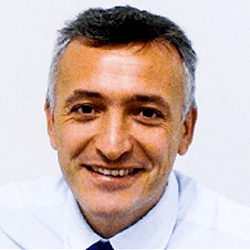One of the megatrends that feature the evolution of our society is the concentration of global population in the cities. Increasing urbanization requires deep rethinking of the services that the utilities provide. This topic has been at the heart of last June’s event, “Re-inventing the city”, that has been organized by Hera in Bologna. To understand how Hera means to play this role, we talked to Enrico Piraccini, who is the Head of Development and Innovation at Hera.
How have you shaped your innovation strategy to pursue the objective of achieving a circular smart city?
Hera pursues six objectives identified as relevant for its business, in the framework provided by the UN’s 17 Sustainable Development Goals. The challenge is to prioritise those goals, as a starting point to generate sound results also in terms of EBITDA. For this reason, we have designed an innovation strategy that considers cities to be organisms, articulated in vital structures that are in continuous exchange. Our role, as a multiutility operator, is firstly to get a check-up on the health of the city, with the aim of developing a course of treatment headed to clear objectives, whose evolution we will monitor and supervise over time.
What is your approach towards the single city?
In the first phase, we place the sensors to collect data and information that we analyze later on, during the diagnostic phase. This way we develop an Environmental Passport for each city, with a series of indicators provided by the local administration. The Passport clearly points out which services are needed or which aspects must see substantial changes. In some cases, air quality could be the priority, somewhere else, an improvement in separate waste collection could be compelling – one size does not fit all. The commitments taken in 2017 at the G7 meeting on the Environment, set out in the Charter of Bologna, include challenging goals to be reached by 2025: those commitments represent our reference point. Every city can measure the progress made so far towards those objectives: through IoT systems, the Environmental Passport provides a constantly updated picture of this path.
What kind of information do you use to make the diagnosis?
The Environmental Passport focuses on different data – those provided by the new CNR probes on air quality, figures about electricity consumptions from households, as well as the measurements on leakages of water networks. We also use satellite data, for example to detect how green areas are distributed throughout the city, or where asbestos is present on the roofs. Once identified the unbalanced situations, Hera is able to suggest the local administration the most effective solution, through services available at very reasonable prices.
Which tools do you offer to the cities to improve their health conditions?
In Hera we developed the proof of concept of a smart bin able to detect the quantity and quality of the waste produced by a single person, thanks to an easy yet performing system. After running a test on 40 families in Castelbolognese, we are considering the introduction of the new bin to 10 thousands inhabitants, who will only need to place their smartphone close to the bin to get access to the area where they can leave the waste; moreover, the whole area is under video surveillance. We can also provide local administrations with an Energy Map that measures the energy efficiency of every house, as well as downstream services in waste collection, following the example of the first plant for the biomethane production that we have built in Sant’Agata Bolognese. As a multi-utility operator, Hera can deploy a series of innovative solutions that make it well positioned in the European context.
What can Hera offer to the inhabitants of the city?
We drive people towards a more conscious and efficient resource consumption path. For example, we have developed a service that combines behavioral economy theories with big data analysis. It includes a report, received with the bill, which analyses the customer consumptions and comparing them with those of similar clients, suggesting practical measures to improve energy consumptions. This service, which we will also add in the water business, shows promising results: participating customers have actually reduced their own consumptions. We also have an offer of new services to make houses more automated and independent from the energy viewpoint, as in the case of Hera Thermo, a smart thermostat that enables the optimal switching on/off of the heating system, avoiding any manual fine-tuning of temperature.
It is essentially about providing smart services…
Not only smart. At Hera, we took strong commitment to bearing in mind the “3 S”, Smart, Safe e Sustainable, whether we are dealing with electricity, water or waste. More specifically, by Safe we mean the ability to become resilient from the environmental point of view. We try to have a broad-based vision, instead of a vertical one – in that being supported by our multiservice business model – with the aim of promoting real sustainability in the complex urban interconnections.
Does the climate change have an impact on your business?
Of course, just think of how water scarcity goes together with heavy rain phenomena, increasing the risks of flooding. An operator like Hera needs to look forward and think of new services that could help cities to collect and drain heavy rains, limit leakages and optimise water consumption.
A dramatic difference with the vision of the old-school multi-utility…
A radical difference, indeed. Yesterday the name of the game was offering products, providing always much more water, gas or electricity to customers. Today the game rules are different. The imperative is to consume less water, gas or electricity and to produce less waste, while the new frontier to focus on is on the services offered.















